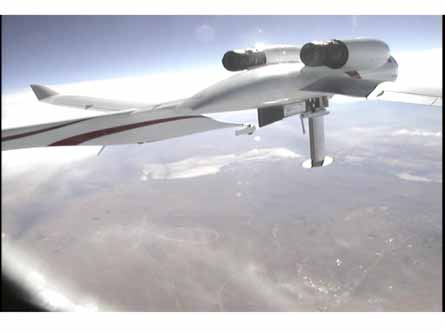Technology could reduce fuel consumption of a medium-range transport aircraft by about 5%, says manufacturer
A small US firm says it is in talks with major manufacturers about applications for its flexible-wing technology following flight tests late last year that demonstrated the expected drag reduction. The mission-adaptive compliant wing (MACW) designed by FlexSys uses a morphing structure to change aerofoil shape smoothly.
Analysis of the flight tests of a wing section mounted under Scaled Composites' White Knight in October-November last year showed drag-reducing laminar flow was maintained over almost 60% of the chord, says FlexSys founder and president Sridhar Kota. "Computational fluid dynamics predicted 60-65% laminar flow and we saw 59-60%. That's a pretty good match, and much better than normal," he adds.
The FlexSys wing uses a morphing structure to change aerofoil shape |
The flight tests involved a Lockheed Martin natural laminar-flow aerofoil with a flexible trailing-edge using FlexSys's morphing technology. The compliant trailing-edge flap can deflect from 10° down to 10° up at 30°/s to vary camber and provide flight control, and can twist along its span by up to 3.3°/m (1°/ft) to provide gust alleviation. In the flight tests, laminar flow was maintained to 8-10° trailing-edge deflection, says Kota.
Ann Arbor, Michigan-based FlexSys calculates its MACW technology could reduce the fuel consumption of a medium-range transport aircraft by about 5%, the savings increasing to as much as 12% when combined with a natural laminar-flow aerofoil.
Kota says initial interest from manufacturers on the military side is in extending the endurance of unmanned air vehicles, and on the civil side in improving the performance of business jets. The company previously tested a compliant leading-edge in a low-speed windtunnel, demonstrating higher lift at lower drag, and is in talks on building one for a small aircraft, he says.
A mission-adaptive wing with smooth variable camber has been demonstrated before, but was mechanically complex and heavy. Embedded in the leading and trailing edges, the company's compliant mechanism and actuators reduce the complexity and weight of variable camber while maintaining a continuous outer mould line for low drag.
Compared with conventional flaps, compliant flaps are about 30% heavier, but require about 32% less chord for the same performance, says Kota. "Then, when you twist the flaps to shed gust loads, you reduce root bending moment and end up with a lighter wing. When you do the system design you end up respectably lighter."
FlexSys has demonstrated a compliant helicopter rotor-blade that morphs once per revolution, the leading-edge deflecting up to 10° to delay retreating-blade stall. Work is now under way on a compliant blade trailing-edge that deflects a few degrees three to four times per revolution to reduce rotor vibration. "The challenge is the weight penalty and power required," says Kota.
Source: Flight International
























